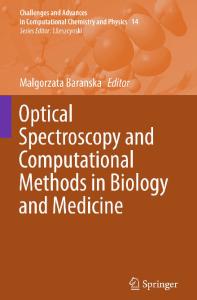Optical Interferometry for Biology and Medicine
This book presents the fundamental physics of optical interferometry as applied to biophysical, biological and medical research. Interference is at the core of many types of optical detection and is a powerful probe of cellular and tissue structure in int
- PDF / 10,574,678 Bytes
- 355 Pages / 439.37 x 666.142 pts Page_size
- 65 Downloads / 294 Views
For further volumes: http://www.springer.com/series/8091
David D. Nolte
Optical Interferometry for Biology and Medicine
David D. Nolte Department of Physics Purdue University West Lafayette, IN, USA
ISBN 978-1-4614-0889-5 e-ISBN 978-1-4614-0890-1 DOI 10.1007/978-1-4614-0890-1 Springer New York Dordrecht Heidelberg London Library of Congress Control Number: 2011940315 # Springer Science+Business Media, LLC 2012
All rights reserved. This work may not be translated or copied in whole or in part without the written permission of the publisher (Springer Science+Business Media, LLC, 233 Spring Street, New York, NY 10013, USA), except for brief excerpts in connection with reviews or scholarly analysis. Use in connection with any form of information storage and retrieval, electronic adaptation, computer software, or by similar or dissimilar methodology now known or hereafter developed is forbidden. The use in this publication of trade names, trademarks, service marks, and similar terms, even if they are not identified as such, is not to be taken as an expression of opinion as to whether or not they are subject to proprietary rights. Printed on acid-free paper Springer is part of Springer Science+Business Media (www.springer.com)
Preface
Light is at once the most sensitive and the most gentle probe of matter. It is commonplace to use light to measure a picometer displacement far below the nanometer scale of atoms, or to capture the emission of a single photon from a fluorescent dye molecule. Light is easy to generate using light-emitting diodes or lasers, and to detect using ultrasensitive photodetectors as well as the now ubiquitous digital camera. Light also has the uncanny ability to penetrate living tissue harmlessly and deeply, while capturing valuable information on the health and function of cells. For these reasons, light has become an indispensible tool for biology and medicine. We all bear witness to the central role of light in microscopic imaging, in optical biosensors and in laser therapy and surgery. Interferometry, applied to biology and medicine, provides unique quantitative metrology capabilities. The wavelength of light is like a meterstick against which small changes in length (or phase) are measured. This meterstick analogy is apt, because one micron is to one meter as one picometer is to one micron – at a dynamic range of a million to one. Indeed, a picometer is detected routinely using interferometry at wavelengths around one micron. This level of interferometric sensitivity has great utility in many biological applications, providing molecular sensitivity for biosensors as well as depth-gating capabilities to optically section living tissue. Optical Interferometry for Biology and Medicine presents the physical principles of optical interferometry and describes their application to biological and medical problems. It is divided into four sections. The first provides the underlying physics of interferometry with complete mathematical derivations at the level of a junior undergraduate student.
Data Loading...











